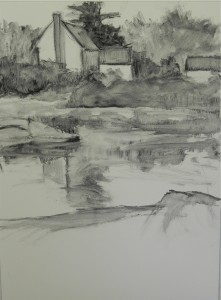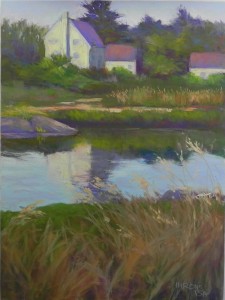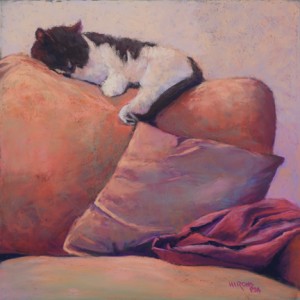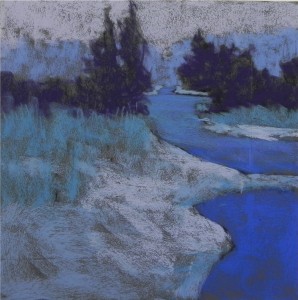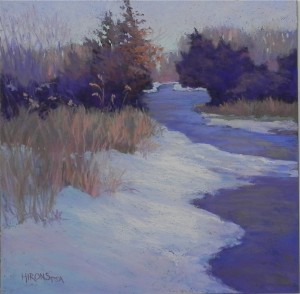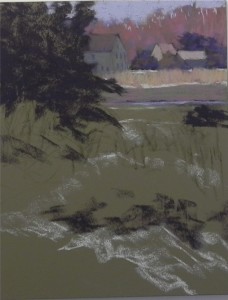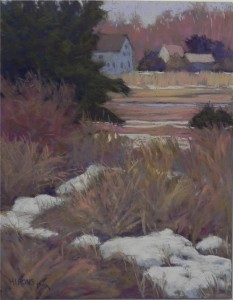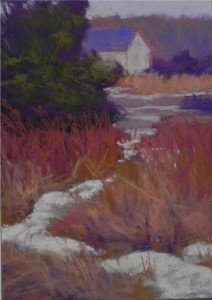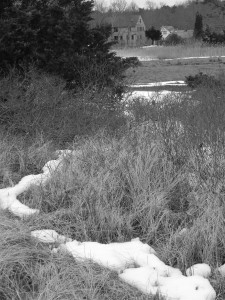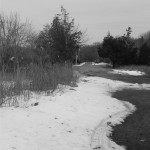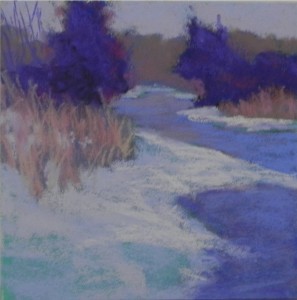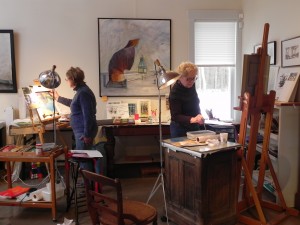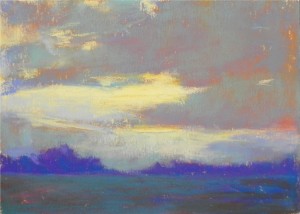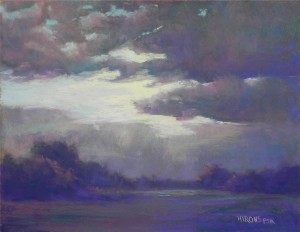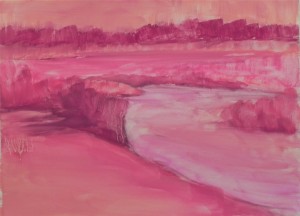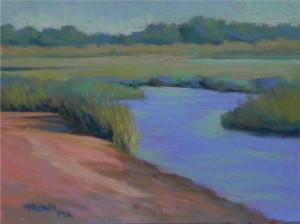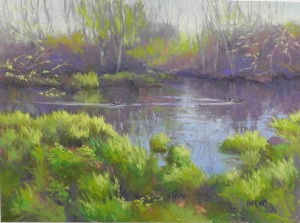This painting was done as a demonstration for my Tuesday class. When I do a demo that has a complicated composition, I like to have it set into the paper or board before I do the demo. I find that using charcoal and water works really nicely for this. I had problems getting the house reflection aligned and changed it a number of times by just adding water and wiping off with a paper towel. The resulting wash gives me a good road map for my painting and doesn’t mix with the subsequent layers of pastel. For this painting, I used hard pastels to do an underpainting, then added soft pastel over. I’ve made a number of changes since the demo, such as warming up the colors in the background and removing distracting flowers from the foreground. One of the challenges was the division of space between the houses, water, and land at bottom. The reflections coming down and the reeds going up, hopefully, tie it all together.
Category Archives: Uncategorized
The “Wow” Factor vs. Pastel Bliss
On Monday I will be holding a discussion with my advanced class on the “wow” factor. I was first introduced to this concept by Richard McKinley at a workshop in 2008. And the Pastel Journal, in its April issue on the Pastel 100, has included a special article on the “wow” factor and what it means for jurists. They cover many things, but the one that seems to be at the center is the emotional factor. When a painting encompasses the “wow” factor it speaks to others. But lately, I’ve been thinking about a different concept–“pastel bliss”–to coin my own phrase. I experienced this last Monday when I did a small 6 x 12 painting in class. The composition came together nicely, I liked the colors, the surface and pastels were working well and every stroke brought enjoyment. And the one problem area was quickly resolved by pieces of grass that I love. (My photo of the painting didn’t work well, but it was filmed yesterday and I will share it when the disk is received.) For now, I’ll share the picture of my mother’s cat, Gracie, another painting that came together in two hours and basically painted itself. The difference that I’m speaking about is the impact on others of some paintings vs. the enjoyment we receive when we paint certain paintings. I guess that perfect bliss is achieved both the pleasure and the “wow” element are combined in the same painting. But sometimes, the pleasure alone is enough. When people ask me at a show what my favorite painting is, invariably it’s the one that I enjoyed painting the most. Others have no knowledge of this and assess the paintings based on their own experiences and how the paintings speak to them. This is as it should be. Which brings me back to the element of emotion in our paintings. This is very difficult for me to describe or define. I rarely like paintings that are too obviously meant to stir the emotions. So I think it’s something that comes from within, from the relationship we have to the subject matter. Last week’s painting was another snow picture from Mattapoisett, from a place I visit every time I’m there and near our first house. So I know the feeling of it well. Perhaps that translates as I’m painting. It’s definitely not a “wow” picture. It’s very quiet and I have no idea whether anyone else would find it emotionally appealing. But it speaks to me.
Snow Shapes
I began this painting on a 12 x 12 gray Pastelbord. I started out with the basic shapes in cool colors and decided to spray with a workable fixative. This gave more tooth to the board and kept the colors from mixing. (Note that I changed the shape at bottom right from the original.) For this painting, I wanted to avoid green completely and used a mix of violets, earth tones, and warm pinks. I added rust to the tree at left to indicate oak leaves still hanging on. This picture was really fun! I love the abstract quality of it and the ability to use a pleasing color palette. The board had lines in it, however, that I strugged to get rid of–an altogether too common problem with this surface. But I love what I can do with it.
Blue House on the Marsh
- Further completion
Here is an early stage and the completed picture for one of two paintings I did today! They are based on the color studies I posted earlier. The first issue was the size. I tried out a 16 x 20, but decided there would be way too much tree! So I used an 11 x 14. The board I had available was a toned brown board. So I began with charcoal and a small amount of light Girault to lay in the basic shapes. I worked down, primarily with Girauls (except for Schmincke in the sky). I really enjoyed adding the little houses to this picture, which didn’t fit in the 7 x 5 study. I also decided to tone down the colors and not use such dark and bright colors. Decided also to use the grayed blue of the house and added grayed blue to the snow in the foreground and other places to add balance. This is a quiet picture, but I’m happy with it. The reeds are all Unisons from their brown earth series.
Snow studies-2
This scene really excited me! I loved the dark tree, open marsh with distant house and the snaking piece of light snow leading the eye into the middle of the picture plane! The color in the photo was almost non-existant. I envisioned using reds for the bushes and warmer earth tones for the grasses and played with a neutral color for the house that is lighter in value than the blue gray that it actually is. I also simplified the background. I will definitely do this in a larger format, no doubt refining the colors, which may be a bit bright. The shape of the board did not allow for the roundness of the tree, which I really like, so I will pay attention to that when selecting a surface on which to work–probably 11 x 14 or 16 x 20.
Snow studies
Here is one of the color studies I did yesterday. The photo in color almost looked black and white, there was so little color! But I like taking pictures of snow on an overcast day when the snow is the lightest shape in the composition. Once I turned it into black and white, I could see all kinds of possibilities that the color photo might have prevented me from using. I started the 6 x 6 color study with cool hard pastels and did an alcohol wash. The aqua I used under the snow can still be seen in the lower left corner. I mixed warms and cools over one another. The lightest light is a very light Ludwig pink, which I used sparingly. The tree forms need refinement and variation in value. But I find the overall composition and color scheme to be very pleasing and will probably move on to a larger format.
Workshops
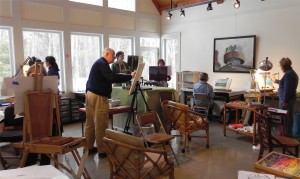
From left: Claire Tremblay (behind easel), Nicole St. Pierre, Colin Browning, Mary Sexton, Janet Gendreau, Helen Bryant, Sarah Brown
I had a wonderful time in Massachusetts with 8 very talented artists. We meet in the beautiful studio of Sandy Bilodeau and the setting is perfect for creativity and sharing. The two themes for this workshop were broken color and loosening up. My first day’s painting really encompassed both of these, the second was less successful! But my struggles gave the opportunity for others to offer solutions and that was great.
Teaching is something that I thrive on. I am fortunate to have groups of people in Maryland and Massachusetts who I can teach on an ongoing basis. But I’m also planning to develop a 3-4 day workshop based on my book that I can give to others. There are many people giving plein air workshops, but what I’d really like to teach is how to successfully work from photographs. While it’s often considered tabu, most of us do it and sometimes not that well! More and more, what I thrive on is working from black and white photos, focusing first on shapes, then using an intuitive approach to the color. The creative process begins when I see something and snap the photo. Then I can play with it on the computer (cropping mainly) and do small studies that might lead to a bigger painting. In my next post, I will show some of these studies from my trip this past week.
If this is something that you think others in your area, or your pastel society would enjoy, let me know. My schedule for 2014 is fairly open. I teach from late Sept. to early April on Mondays and Tuesdays, but have a little flexibility. From April to early September, I can be available to give a workshop. You can email me at: jeanhirons@comcast.net.
In other news, you can read an interview with me at http://laboocks.blogspot.com/2013/02/an-interview-with-artist-jean-hirons.html. Thanks to Lori-Ann Boocks, whose beautiful paintings were recently shown at my church in Bethesda.
Using Intuitive Color
For my advanced class this week, I was to do a demo on working from a black and white photo using intuitive color. Last Monday I spent time doing color studies and chose the one given in this post. I liked the use of warm color under cool. When I began doing the demo, however, I began with warm, moved to blue greens, then started using cool pinks and majentas! All of a sudden I had a completely different color scheme! But I liked it and decided to stick with it. My challenge was what to do with the sky. I began with very light aqua and pinks, to keep with the cool red and greens. then put in the lightest soft yellow that I had. It is noticeably cooler than the yellow used in the color study but it definitely added brightness. It has more of a silvery quality, I think. The 11 x 14 format gave more room for the land and I decided to add a layer in the front so as not to have the solid line going across the bottom. The resulting picture is darker than the study, but I like it. I’m considering doing it again on a 16 x 20 pastelbord to see what happens that time. If I do, I’ll post it! The main lesson here is to let the painting speak to you. Once I started going in a new direction and liked it, I kept with it and put away the color study. I may frame both!
Abstracting
- Underpainting for Marshscape
Next week I’ll be in Mattapoisett, MA giving a workshop to a wonderful group of people I’ve been with since 2009. One of our topics is loosening up to incorporate more abstraction in our paintings. While I will never be a purely abstract artist, l like to begin my paintings with strong abstract shapes. It was the shapes of the water, foreground grasses and sand bank that drew me to this image from Mattapoisett. I’m going to do a demo from it next week and decided to do something today in advance. I worked from a black and white photograph so as to be completely free to chose my colors (one of the ways I like to loosen up). I decided to play with two things I seem to have a hard time with: 1) using more of a blue green palette and 2) using a tonalist value scheme. I began with a hard pastel underpainting in various reds. In laying on the initial colors, I tried to let some of the underpainting show through. Over time, I cancelled most of it out, but there are still bits and pieces poking through. I used a mid light blue green for the sky, later adding a little blue violet to relate to the violet in the water. A hallmark of some tonalist landscapes is a darker sky that is not in strong contrast with the land. I couldn’t resist using some strong darks in the foreground grasses and placed other small pieces of dark to lead the eye back into the channel. To offset the pinky oranges in the foreground, I layed some soft pink over the distant grasses. The only strong lights and darks are in the foreground, with the background primarily differentiated by subtle temperature shifts. I used nothing but soft pastels in the painting in order to keep it as painterly as possible. I find that the UART 400 is great for these types of applications.
Using a Light Touch
For this quiet picture, I used a different approach from my last painting. I decided that this is a center of interest painting, rather than big shape (even though the shapes are really critical in this painting) and decided to work on Wallis mounted museum grade white paper. I used a watercolor underpainting and primarily used Girault pastels. (I did not use hard pastels because I wanted to begin with more grayed tones that are not available in the hard sticks). The soft pastels were limited to the bright yellows and yellow greens in the foreground, but a lot of these are also Girault. When I work on Wallis, I like to use a light touch, barely touching the pastel to the paper. I learned this from watching Albert Handell and Richard McKinley. Wallis paper is “pastel grabber” in my definition, in that it readily accepts the pastel with little resistance. For this reason, I like to use the grainy Giraults, which can leave very soft layers without cakey build up. Compositionally, I found a number of challenges in the original photo. The photo was taken in fall, so there were a number of oranges, including the bright grasses on the far shore. I tried putting that in as orange, but it distracted from the bright yellows of the foreground grasses, which were where I wanted the eye to go. I added a third little duck in this area to enhance the center of interest (I seem to be into ducks lately!). Using greens in the background, instead of the warmer oranges and reds of the photo, helped tie the picture together. The foreground greens are so strong. I introduced a lot of the background violet into them, along with small pieces of orange. Another change to the composition was to bring the water down into the lower right of the composition. The original shape was too straight and boring. This added a degree of tension and more interesting shapes that I found pleasing. While the sky looks pretty bland, I added a number of blues to it, but kept them subtle and they don’t show up very well in the image. The quietness is enhanced by the horizontal format, the use of many grayed colors, and the subject matter of ducks swimming on a peaceful river. The only excitement is in the light hitting the foreground grasses, which I tried to limit.

